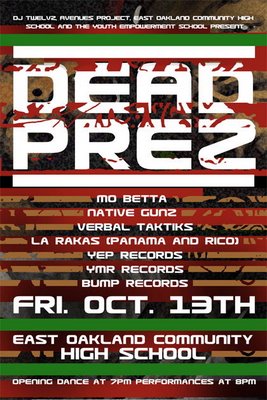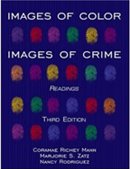Wednesday, January 09, 2008
Thursday, May 17, 2007
Unstoppable

So the Avenues Project which brings arts education to East Oakland Community High School was given the boot by the state. Although we currently don't hold classes at EOC students have chosen to continue photography outside of school and form a Photography Collective. Still in its budding phase, the young photojournalists have been meeting at each other's houses and in cafes to lay out their foundation. Their upcomming projects include the Avenues Project Expo event and they also plan to crash the EOC Exhibition with their own presentations. Stay tunned for more info.
Wednesday, April 25, 2007
Makin Connections, Thanks Keba Konte!

Our class just hooked up with a tight workshop from Keba Konte on photomontage on wood. Keba's work is the result of resisting to conform to traditional forms of photography and using innovation inspired by creative spirit, as he states:
Working in this medium has been very liberating, allowing me out of the darkroom and into the salvage yards and dumpster bins. It has released me from the glass and pristine white mattes to a more spontaneous method of working and thinking. As well, it has enabled me to expand in scale and dimension. It's an adventure.

This Sunday students will be visiting his Guerilla Cafe to meet for lunch, viewing his "88 Pieces of Me" exhibition, and to talk about forming a photographers collective outside of the confines of the school day.
Stay tuned for results of their work to be posted here. Also in progress is a documentary on East Oakland Youth Street Photojournalists.

Images by Keba Konte
Monday, April 23, 2007
East Oakland meets Palestine.
Young photojournalists from East Oakland met with young photojournalists from Balata, a camp within the West Bank of Palastine, during their Picture Balata tour in the U.S. Youth from both places discovered the similarities of living in states where political, economic, and cultural repression affect the everyday lives of children and families. Palestinian and East Oakland youth shared images and testimonial essays that reflect the experiences of their every day lives. Through discussions and other activities, youth from both nations revealed to each other that violence, social marginalization, as well as resistance and an emphasis on education are some of the factors that inform the every day realities of young people and their families. As a stepping stone to building international awareness and coalition opportunities, this was a beautiful and powerful experience filled with hope, insight, and the recognition of the state of humanity among people of different nations who refuse to cease to resist repressive regimes.
We also made a trip to the beach, which was particularly significant for the youth from Balata, who although live right by the Mediterranean Sea, have never seen the ocean due to lack of access by Israeli military.
Images by Steve Wake and Deonte
We also made a trip to the beach, which was particularly significant for the youth from Balata, who although live right by the Mediterranean Sea, have never seen the ocean due to lack of access by Israeli military.
Images by Steve Wake and Deonte
Wednesday, April 04, 2007
SOVEREIGNTY
Understanding the right of sovereignty.
Are we participants of a sovereign nation?
Sovereignty: The union and exercise of all human power possessed in a state; it is a combination of all power; it is the power to do everything in a state without accountability; to make laws, to execute and to apply them: to impose and collect taxes, and, levy, contributions; to make war or peace; to form treaties of alliance or of commerce with foreign nations, and the like.
Bouvier's Law Dictionary (1856 Edition)
Cultural Sovereignty: The right for the people of a community or nation to observe cultural practices without persecution or repercussion. This includes the practice of religious practices, the use of native languages, the practice of place making, and the carrying out of other forms of traditional customs. The understanding of a cultural and historical cohesion among the people of a sovereign nation.
Economic Sovereignty: The right for the people of a community or nation to have sufficient and equal access to the means of economic survival and self-determination. How individuals gain access to these means is determined by the nation/community and is not dictated by those outside of the nation/community.
Political Sovereignty: The right for the people of a community or nation to govern themselves. This includes the production laws, systems of accountability, and the right for the people to choose their own political leaders without interference from those outside of the sovereign nation.
Students will investigate issues of sovereignty within their communities in East Oakland. Students will also have the opportunity to interact with young photographers from Palestine who are touring the U.S. Connections between challenges of sovereignty in East Oakland and Palestine will be made through picture swaps, discussions, and other activities.
Are we participants of a sovereign nation?
Sovereignty: The union and exercise of all human power possessed in a state; it is a combination of all power; it is the power to do everything in a state without accountability; to make laws, to execute and to apply them: to impose and collect taxes, and, levy, contributions; to make war or peace; to form treaties of alliance or of commerce with foreign nations, and the like.
Bouvier's Law Dictionary (1856 Edition)
Cultural Sovereignty: The right for the people of a community or nation to observe cultural practices without persecution or repercussion. This includes the practice of religious practices, the use of native languages, the practice of place making, and the carrying out of other forms of traditional customs. The understanding of a cultural and historical cohesion among the people of a sovereign nation.
Economic Sovereignty: The right for the people of a community or nation to have sufficient and equal access to the means of economic survival and self-determination. How individuals gain access to these means is determined by the nation/community and is not dictated by those outside of the nation/community.
Political Sovereignty: The right for the people of a community or nation to govern themselves. This includes the production laws, systems of accountability, and the right for the people to choose their own political leaders without interference from those outside of the sovereign nation.
Students will investigate issues of sovereignty within their communities in East Oakland. Students will also have the opportunity to interact with young photographers from Palestine who are touring the U.S. Connections between challenges of sovereignty in East Oakland and Palestine will be made through picture swaps, discussions, and other activities.
Race, Culture, and the Politics of Public Space
Through reading passages from Haymes' Race, Culture, and the City: A Pedagogy for Black Urban Struggle our photojournalists reviewed the theory of public "space as a metaphor" where power struggles and resistance are represented through the ways in which people and institutions make use of public space on a day to day basis. Some of the concepts we covered in class are:
Placemaking: The formation and use of public space through principles of culture, ideology, or politics.
Centralization: Upholding a particular perspective, idea, or principle as an authoritative position above all other perspectives, ideas, or principles
To DECENTRALIZE is to remove an idea, perspective, or principle from its assumed authoritative position.
Gentrification:The displacement of a group of people by another, more economically wealthy group of people.
The displacements of local businesses, housing, or any public spaces or institutions that support the group of people being displaced.
Commodification of Culture: The distortion of culture from its historical and/or political context for the purpose of consumerism and economic capital.
Spaces of Self-Actualization:The formation and use of public spaces that not only resist oppression but also creates community self awareness.
Students are in the process of researching how these terms play a role in their own communities in East Oakland.
More to Come!
Placemaking: The formation and use of public space through principles of culture, ideology, or politics.
Centralization: Upholding a particular perspective, idea, or principle as an authoritative position above all other perspectives, ideas, or principles
To DECENTRALIZE is to remove an idea, perspective, or principle from its assumed authoritative position.
Gentrification:The displacement of a group of people by another, more economically wealthy group of people.
The displacements of local businesses, housing, or any public spaces or institutions that support the group of people being displaced.
Commodification of Culture: The distortion of culture from its historical and/or political context for the purpose of consumerism and economic capital.
Spaces of Self-Actualization:The formation and use of public spaces that not only resist oppression but also creates community self awareness.
Students are in the process of researching how these terms play a role in their own communities in East Oakland.
More to Come!
Sunday, November 19, 2006
Forms of Violence
We are looking at forms of violence outside of what is usually represented in the media (direct violence). We've discussed symbolic violence, structural violence, and violence as a state of tension (Fanon), described in the previous post below. In this post are some events that others have blogged about that expose these other forms of violence. Identify how these forms of violence play out within the events on the following links (5 points per link for students, but anybody is welcome to post!):

Blackademic writes:
"last week, on the campus of texas a&m university, a couple of students posted a video on a public web forum, depicting the act of a “slave” (a white student in blackface), being whipped by a “master” (another white student in blackface)."
BrownFemi discusses the incident of an Iranian-American UCLA student that was shot with a taser gun by UCLA’S UCPD November 14th 2006. He believed he was targeted because of his middle eastern appearance.
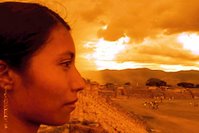
BrownFemi also discusses paramilitary action against the indigenous people of Oaxaca, Mexico who are struggling to resist the exploitation of their land and labor.

Maia makes the connection between capitalism and its limitations on the right of young motherhood for young mothers (and other mothers) who want to choose to give birth but are faced with a society that demonizes this act and devalues motherhood.

Tiffany of BlackFeminism highlights Kenji Yoshino's thesis on the new civil rights movement, by discussing the effects of assimilation or "covering." He makes a link between the limitation of an individual's freedom of cultural expression and denial of civil rights, such as Claire Anderson in Atlanta who was fired from teaching because she decided to switch to wearing her natural hair.

Blackademic writes:
"last week, on the campus of texas a&m university, a couple of students posted a video on a public web forum, depicting the act of a “slave” (a white student in blackface), being whipped by a “master” (another white student in blackface)."
BrownFemi discusses the incident of an Iranian-American UCLA student that was shot with a taser gun by UCLA’S UCPD November 14th 2006. He believed he was targeted because of his middle eastern appearance.

BrownFemi also discusses paramilitary action against the indigenous people of Oaxaca, Mexico who are struggling to resist the exploitation of their land and labor.

Maia makes the connection between capitalism and its limitations on the right of young motherhood for young mothers (and other mothers) who want to choose to give birth but are faced with a society that demonizes this act and devalues motherhood.

Tiffany of BlackFeminism highlights Kenji Yoshino's thesis on the new civil rights movement, by discussing the effects of assimilation or "covering." He makes a link between the limitation of an individual's freedom of cultural expression and denial of civil rights, such as Claire Anderson in Atlanta who was fired from teaching because she decided to switch to wearing her natural hair.
Wednesday, November 15, 2006
Racism and Violence
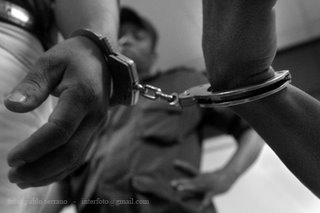
Photo by Pablo Serrano
Racism
Power + Prejudice (racial) = Racism
• One person cannot be racist by themselves, racism occurs along with institutional or structural backing or support
Structural Violence
Johan Galtung originally framed the term structural violence to refer to any constraint on human potential due to economic and political structures (1969). Unequal access to resources, to political power, to education, to health care, or to legal standing, are forms of structural violence.
• Almost always invisible
• Normalized by stable institutions and regular experience
• Occurs whenever people are disadvantaged by political, legal, economic or cultural traditions
• Because they are longstanding, structural inequities usually seem ordinary; the way things are and always have been
• Often requires police states to suppress resentments and social unrest
• Includes cultural genocide
(Winter and Leighton, Introduction to Structural Violence, 1999)
Symbolic Violence
• Dominant group’s imposition or use of symbols or meanings to maintain power
• Meanings behind symbols are experienced as “legitimate” or “human nature” through controlling the educational mechanisms that produce and reproduce these symbols
Symbolic violence manifests through “the subtle exercise of symbolic power waged by a ruling class in order to ‘impose a definition of the social world that is consistent with its interests’” (Bourdieu and Passeron, Reproduction in Education, Society and Culture 1977).
Examples of symbolic violence may include:
• Relentless stereotyping
• The media’s exclusionary standards of beauty
• educational system’s insensitivities to the needs of multicultural communities
• Words and body language
• Show of force in marginalized communities by people in power
Many whites in all sectors of society acquiesce or participate in acts of symbolic violence even though they disapprove of physical violence (Feagin and Vera, White Racism: The Basics, 1995).
Frantz Fanon's Violence as a State of Tension
"The colonized man will first manifest this aggressiveness which has been deposited in his bones against his own people... When the native is confronted with the colonial order of things, he finds he is in a state of permanent tension. The settler's world is a hostile world, which spurns the native, but at the same time it is a world of which he is envious. We have seen that the native never ceases to dream of putting himself in the place of the settler..." (52). - Wretched of the Earth
Quotes on dehumanization in the media
A few quotes that came from our conversations, based on student lead presentations, on the role of dehumanization, racism, and stereotypes in the media:
Daniela: "The media focuses attention on what people of color are doing bad and focus away from what white people are doing bad."
Jasmine: "The media helps white people get away with stuff."
Daniela: "The media focuses attention on what people of color are doing bad and focus away from what white people are doing bad."
Jasmine: "The media helps white people get away with stuff."
Monday, October 02, 2006
Stereotypes in the Media and Perscription

Students are preparing on being able to speak about how stereotypes about people of color dehumanize and cause real affects in our everyday living. Two of the articles we will discuss are "Murderers, Rapists, and Drug Addicts" by Dennis M. Rome and "Latinos, Gangs, and Drugs" by Edwardo L. Portillos.
 Links between Friere's concept of dehumanization, perscription, and fear of freedom will be made when students facilitate discussions around these issues.
Links between Friere's concept of dehumanization, perscription, and fear of freedom will be made when students facilitate discussions around these issues. Our experienced Photography Specialists are tightening up their skills and prepping to facilitate the class through acquiring the basic skills in black and white photography.

Friday, September 15, 2006
Student Responses on Friere
"Freedom is acquired by conquest, not by gift." -Friere
In response to this quote:
"You are not born free, its not something you just get, you got to fight for your freedom, you got to suffer for your freedom."
-Leti
How can Photographers play a role in transformation?
"We will take images about what's real in today's world, and let those know what's being taken away from them, that is knowledge." -LaKeshia
"Photographers can be a witness in this situation, like caterpillars and butterflies. The revolutionaries would start small than come together and change. In the beginning its hard, there's conflict and struggle. But by the end the butterfly bursts and opens with its wings." -Daniel
In response to this quote:
"You are not born free, its not something you just get, you got to fight for your freedom, you got to suffer for your freedom."
-Leti
How can Photographers play a role in transformation?
"We will take images about what's real in today's world, and let those know what's being taken away from them, that is knowledge." -LaKeshia
"Photographers can be a witness in this situation, like caterpillars and butterflies. The revolutionaries would start small than come together and change. In the beginning its hard, there's conflict and struggle. But by the end the butterfly bursts and opens with its wings." -Daniel
Paulo Freire's concept of Dehumanization
This is an overview of some of the key concepts we've covered in class on Paulo Friere:
Dehumanization is a DISTORTION of the vocation of becoming more fully human.
Dehumanization occurs within our history but it is not our given destiny or "human nature," therefore it can be challenged.
The OPPRESSED restore the humanity of BOTH oppressors and oppressed, through struggling for their own humanity.
"Fear of freedom" locks you into two roles:
-desiring the role of the oppressor
-submitting to the situation of being oppressed
Prescription is the oppressor's tool for attempting to control our thoughts and actions.
Freedom requires the oppressed to reject these two roles and the oppressor's prescriptions and replace them with autonomy and responsibility.
Freedom takes work and dedication.
Freedom is acquired by conquest, not by gift.
To achieve freedom we must:
-critically recognize its causes
-transform our actions
-recreate our reality in the process of human completion
To have never known freedom, is to have never experienced humanity to the fullest.

Image taken by Charlita Hoskins
Dehumanization is a DISTORTION of the vocation of becoming more fully human.
Dehumanization occurs within our history but it is not our given destiny or "human nature," therefore it can be challenged.
The OPPRESSED restore the humanity of BOTH oppressors and oppressed, through struggling for their own humanity.
"Fear of freedom" locks you into two roles:
-desiring the role of the oppressor
-submitting to the situation of being oppressed
Prescription is the oppressor's tool for attempting to control our thoughts and actions.
Freedom requires the oppressed to reject these two roles and the oppressor's prescriptions and replace them with autonomy and responsibility.
Freedom takes work and dedication.
Freedom is acquired by conquest, not by gift.
To achieve freedom we must:
-critically recognize its causes
-transform our actions
-recreate our reality in the process of human completion
To have never known freedom, is to have never experienced humanity to the fullest.

Image taken by Charlita Hoskins
Saturday, September 09, 2006
Wednesday, August 30, 2006
Young Streets Photojournalists Gettin' Ready to Document the Town..
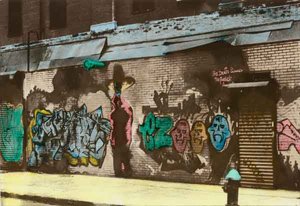
East Oakland Community High School students enrolled in our Street Photojournalism course will take on some theory and mental training before hittin' the avenues with cameras and critical eyes. Our goal is to offer the world an accurate and true representation of youth of color in urban hoods like East Oakland. As we've already gotten into in class, mainstream media tends to warp who we are for the profit of a few. Dehumanizing images like those of Saartijie Baartman (also known as the "Hottentot Venus")
 are still used today to take away the humanity of populations of people, mainly people of color. Our goal is to examine how this takes place today, to develop the tools to create our own media of ourselves, and through our images expose the causes and affects of dehumanization and violence imposed on us from those in power.
are still used today to take away the humanity of populations of people, mainly people of color. Our goal is to examine how this takes place today, to develop the tools to create our own media of ourselves, and through our images expose the causes and affects of dehumanization and violence imposed on us from those in power.

